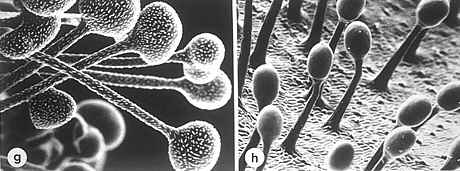a. Single-celled, silicified hair at the leaf surface of Cannabis indica (hemp). Such silicified hairs are restricted to the order Urticales and serve different functions, like the climbing hairs of hop (Humulus) or the stinging hairs of the stinging nettle (Urtica). These hairs are very well-suited for classification. The only possibility within the European flora to mistake Cannabis would be hop (due to this fine-structural feature). b. Single-celled hooked hairs on the leaf of a bean (Phaseolus vulgaris). They might help the plant in its climbing growth or they might be defence gadgets against greenflies. In the Balkans, bean straw was formerly put into beds that were infested by bedbugs: the insects are caught in the barb hairs and perish.

rock rose (Cistus villosus, Cistaceae). d. Absorbing scales at the leaf surface of Tillandsia spec. e. Fluke-like thorn of a prickly pear (Opuntia). The thorn is actually a microscopically reduced leaf. Within the cactus group are these glochids restricted to the Opuntiodeae subfamily. f. Complexly built barb structure: a hair of Loasa (Loasaceae). It consists of a single cell; complex single-celled barb hairs are a characteristic feature of the Loasaceae family.

g. Single-celled knob-shaped hairs from the flower of a snapdragon (Anthirrhinum majus) with complicated cutin structures. h. Multicelled knob-shaped hairs (glands) at the leaf of a carnivorous sundew (Drosera capensis). The complex knob-shaped glandular hairs are used for animal trapping and digestion, they secrete and absorb. (W. BARTHLOTT, 1980, 1981; W. BARTHLOTT, 1986)
